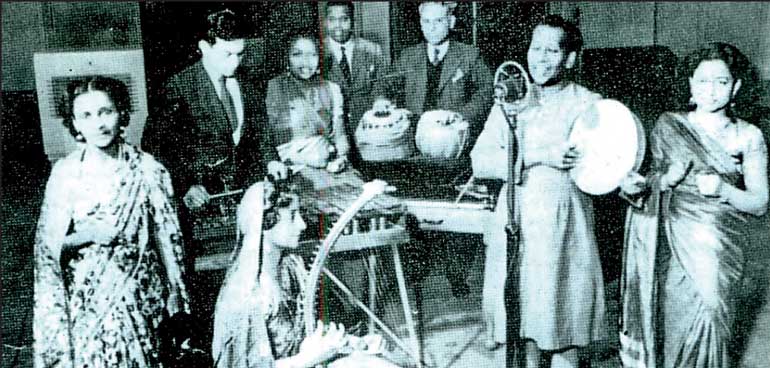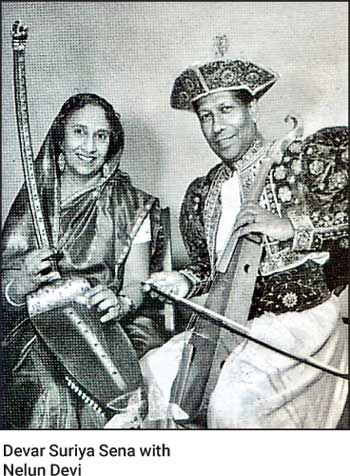Tuesday Apr 15, 2025
Tuesday Apr 15, 2025
Saturday, 6 April 2024 00:00 - - {{hitsCtrl.values.hits}}
 Ceylonese in London recording Sinhala folk songs for H.M.V.
Ceylonese in London recording Sinhala folk songs for H.M.V.
This article is produced to commemorate the birth anniversary of Devar Surya Sena which fell on 29 March, as part of the Harmony Page goal of promoting Intangible Cultural Heritage of Sri Lanka and the world at large as a route to celebrating everything that is aesthetic and thereby humanistic.
 By Kamani Samarasinghe
By Kamani Samarasinghe
Devar Surya Sena was born and bred in Sri Lanka but was educated from preparatory school up to university in England. He was a professional lawyer. Music has been one of his passions since childhood. Through music, he hoped to introduce Eastern culture to Western societies. He also believed that music was a means of bringing people together. He is a pioneer in the revival of Sri Lankan folk music.
He was born on 29 March 1899. His father was Sir James Pieris, a member of the Legislative Assembly and a prominent member of the country’s aristocracy. His childhood name, as baptised, was Herbert Charles Jacob Pieris. In 1908 his entire family sailed to England. He received his preparatory education at St. Paul’s preparatory school, Hammersmith, and secondary education at Tonbridge School in Kent, UK. He obtained a Master’s degree from Cambridge University (1919-1923). Apart from this, he also completed his Bar Study Course in England.
Throughout his student years, music continued to be his main interest. He was a member of the Tonbridge School choir and orchestra. At Cambridge, he sang in the St. John’s choir. He obtained the ARCM (Associate of the Royal College of Music) in solo singing from the Royal College of Music, London. He married Winifred De Silva (the eldest daughter of Dr. Charles de Silva – a famous physician from Galle) on 25 September 1923, in London. He returned to Ceylon in 1924 and took oaths as an Advocate of the Supreme Court.
Herbert Pieris assumed the name of Devar Surva Sena that we know today. His wife, Winifred, followed suit and also changed her name to Nelun Devi. In 1927 he decided to give up his career at the Bar and devoted his life to singing. He learned that a singing career can provide him with more bliss than a legal job. He has also realised that the materialistic mindset of society, in which success is measured by riches, is repugnant to him, and that he desired to pursue a job that provided him with spiritual satisfaction. He was particularly fond of folk music and folk songs sung by the common folk. He proceeded to learn the traditional Sinhalese music and dance traditions that were distinctive to the Sinhala culture. He travelled around Sri Lanka in search of people who knew traditional folk music. He began to methodically collect and write down varieties of folk songs such as the harvesting and reaping songs, the fisherman’s songs, vannamas, lullabies, love songs, and children’s songs that exemplify the common people’s way of life. In 1928, he sang English songs, a Sinhala Nadagam song, and a Nepalese folk song called “Rani banai ma” in front of the Duchess of York in London, demonstrating his enthusiasm for different forms of music. He and Nelun Devi toured Europe, America, and Canada, conducting various music concerts. The goal of these tours was to give a common platform for individuals of many races, creeds, and interests to come together.
After collecting folk songs and Vannamas, he decided to introduce them to the public of Colombo and arranged a concert at the Royal College hall in 1929. Several of the folk songs sung in this Colombo performance, accompanied by his wife, using traditional musical instruments, were well received by the Ceylonese and the European audience. Traditional Sinhalese music and folk songs were unfamiliar to the elite class at the time. He discovered that folk songs were universal and chose to go to countries such as India, Nepal, and Tibet to learn their folk songs.
Surya Sena, who has an insatiable drive to learn music, continued to study Western music, and folk music and travelled to India (1930-1932) to study Indian music. He attended Lucknow’s College of Hindustani Music, Calcutta’s Sanghit Sangha, and Tagore’s Shanthi Niketan. Several of Tagore’s Bengali songs were transcribed in western notation by him. He considered this transcribed Tagore’s Bengali song collection, with Bengali words in phonetic scripts and English translations, to be one of his most prized productions. In 1946 he was invited by H.M.V (His Master’s Voice) company to record Sinhalese folk songs in their studio in Hayes, Middlesex. Malay Malay Oya Namala, Doyi Doyi Doyi (Sinhalese Lullaby), Sinhalese Children’s Songs, and Gajaga Vannama/Ukusa Vannama are examples of his H.M.V tapes. In 1953, he was awarded OBE by Queen Elizabeth II for his services to music. Surya Sena, being a Christian, incorporated traditional folk tunes into the country’s Church music. Along with Lakdasa de Mel, a priest at the Christ Church Baddegama, he pioneered the Sinhala Church liturgy, which used traditional folk tunes as the foundation for a good proportion of the church service. Their aim was to convince the country’s pro-Western residents to appreciate the Sinhala culture that they had inherited. He introduced appropriate Sinhala verses and folk melodies for harvest hymns.
The majestic theme of the Gajaga Vannama fitted the Sanctus and Sivpada tunes for the Agnus Dei of Church liturgy by Surya Sena and de Mel. The setting in Sinhala liturgy is still sung in many churches in Sri Lanka. Surya Sena was the music editor of the Sinhala hymnal book published in 1959 with 168 hymns covering the entire Christian year with music notation for the melodies.
In 1966 he was appointed vice chairman of the Ceylon Broadcasting Corporation. He helped to make the lives of thousands of fellow beings more cheerful through song and dance. After many dedicated years of service to the nation, he died on 11 November 1981.
In accordance with his wish the Devar Surya Sena trust was inaugurated and his residence “Gitanjali” at Alwis Place, Colombo 3 donated for the furtherance of education, music, culture, and fine arts.
(The writer is a Senior Lecturer in Information Technology at the University of the Visual & Performing Arts who promotes archiving of artistic heritage.)